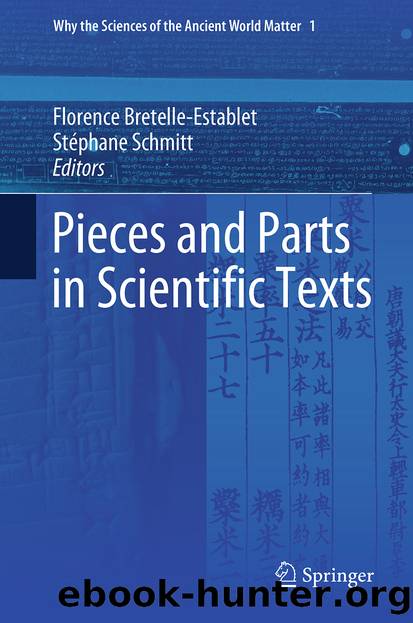Pieces and Parts in Scientific Texts by Unknown

Author:Unknown
Language: eng
Format: epub
ISBN: 9783319784670
Publisher: Springer International Publishing
Fig. 7.7Ms. 57106/416, National Museum, New Delhi
Mostly, however, commentaries composed on a particular text are not transmitted âonâ it, in the sense that their text follows upon the full basic text in the same manuscript or is written section by section after the graphically distinguished portions of the basic text to which they refer, as is very frequently the case in modern printed editions. The regular scribal practice thus reveals an authorial attitude, namely, that the commentators presumed the knowledge of the memorized reference text on the part of their readers or its availability otherwise. The usual practice of the commentators is to refer to the reference text with short quotations of the first word or words of the textual segment on which they are about to comment, the so-called pratÄ«ka-s. These short quotations of segment-initial words probably evoked the memorized text segment immediately and were much more efficient in this respect than the reference by means of a numbered generic segment name, complete with an indication of its segment-hierarchical context,130 or even by means of some content-related lower-level segment designation. Alternatively, the commentators may quote individual wordsâliterally or grammatically adjusted to the syntactical context of their comments, or extracted from longer nominal compoundsâor phrases for comment, explanation or glossing. Both modes of reference to the basic text are seen, for example, with the oldest completely preserved commentary on the Carakasaá¹hitÄ by CakrapÄá¹idatta (eleventh century).131 Even though his ÄyurvedadÄ«pikÄ is a rather extensive commentary , only a fraction of the basic text is documented in this way in its text as found in the manuscripts. The same applies to Uddyotakaraâs sixth-century commentary on the NyÄyabhÄá¹£ya , and many more examples could be adduced. Sometimes, especially in the case of sÅ«tra-s , the complete text commented upon may indeed be quoted in a commentary, but is not necessarily graphically distinguished from the running text of the commentary. This is the case of embedded transmission of a textâgraphically and linguisticallyâaddressed above, with the example of the transmission of the NyÄyasÅ«tra embedded in the NyÄyabhÄá¹£ya .132
As already mentioned, the editors of commentaries in modern editions often print the full reference text on top of the page, and beneath it the text of the commentary relating to it, including the partially quoted reference text. Similarly, they insert chunks of the full reference text between larger portions of a commentary on a series of stanzas , sūtra-s or other segments of the basic text that are only partially quoted or otherwise referenced in the commentary . These practices, meant for the convenience of the reader, occasionally result in a misleading and confusing picture, which is not always detected as such by the reader, when it turns out upon closer inspection that the commentator does not refer to exactly the same reference text, in terms of its precise wording and constitution, as the one printed along with it. They thus reflect a disregard or ignorance of historical developments of the basic text in the course of its transmission .
Download
This site does not store any files on its server. We only index and link to content provided by other sites. Please contact the content providers to delete copyright contents if any and email us, we'll remove relevant links or contents immediately.
The Power of Myth by Joseph Campbell & Bill Moyers(989)
Half Moon Bay by Jonathan Kellerman & Jesse Kellerman(941)
A Social History of the Media by Peter Burke & Peter Burke(926)
Inseparable by Emma Donoghue(911)
The Nets of Modernism: Henry James, Virginia Woolf, James Joyce, and Sigmund Freud by Maud Ellmann(820)
The Spike by Mark Humphries;(755)
The Complete Correspondence 1928-1940 by Theodor W. Adorno & Walter Benjamin(735)
A Theory of Narrative Drawing by Simon Grennan(735)
Culture by Terry Eagleton(698)
Ideology by Eagleton Terry;(687)
Bodies from the Library 3 by Tony Medawar(673)
World Philology by(668)
Farnsworth's Classical English Rhetoric by Ward Farnsworth(665)
Game of Thrones and Philosophy by William Irwin(660)
High Albania by M. Edith Durham(646)
Adam Smith by Jonathan Conlin(637)
A Reader’s Companion to J. D. Salinger’s The Catcher in the Rye by Peter Beidler(633)
Comic Genius: Portraits of Funny People by(609)
Monkey King by Wu Cheng'en(600)
